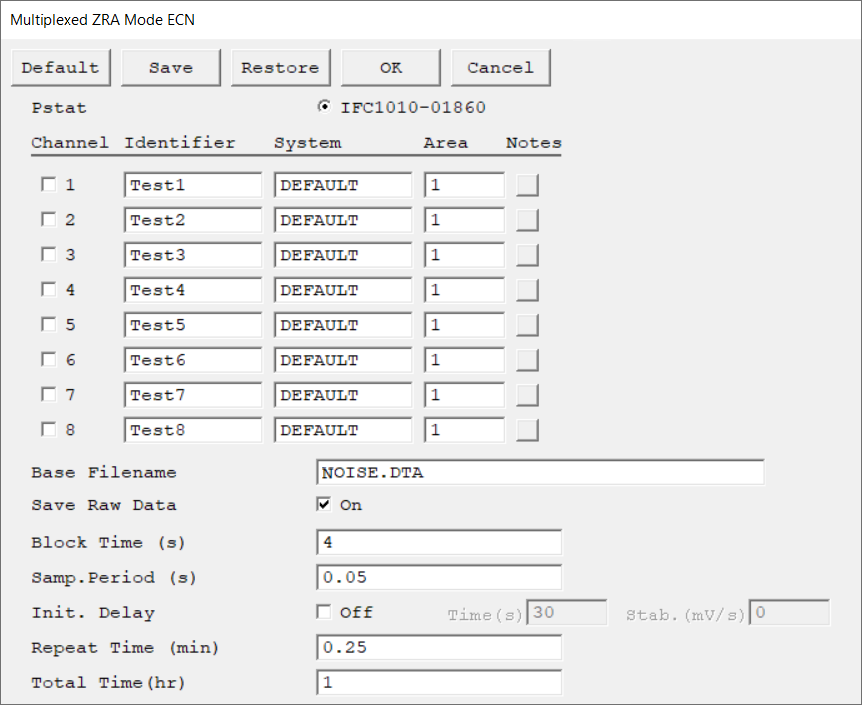Description
Parameter |
Description |
Units |
||
|---|---|---|---|---|
Select the potentiostat/galvanostat to perform the experiment. Each radio button corresponds to an installed potentiostat. You can select only one potentiostat at a time. Potentiostats that are already in use are marked with an asterisk. They can be selected but cannot be used.
|
|
|||
There is one Channel Setup switch for each of the 8 channels. Click the checkbox to select a specific channel. As the script loops through the channels, it only runs tests on channels that are selected. The selected channel numbers do not have to be continuous. |
|
|||
A string that is used as a name. It is written to the data file, so it can be used to identify the data in database or data manipulation programs.
The Channel Identifier string is virtually identical to the Test Identifier string. The only difference is that in multiplexed tests, the Identifier refers to an experiment run on a single cell and not to the entire experimental run. |
|
|||
Select a set of electrochemical parameters relevant to your particular test system. The parameters are recovered from the system parameter database file. The recovered parameters are all used for the calculation of the corrosion rate. They are the sample's equivalent weight, density, anodic β and cathodic β. When you attempt to run an experiment, the system searches the SYSTEM.SET file for a parameter set stored under the name in the System parameter. If the software finds no parameter set, an error message appears and you are returned to the Setup dialog box. |
|
|||
The electrode area that is used in calculations. It can be set individually for each channel. |
cm2 |
|||
Enter several lines of text that describe the experiment. There is a separate entry for each channel in a multiplexed test. A typical use of Channel Notes is to record the experimental conditions for a data set.
The Channel Notes controls are similar to the Notes control described for non-multiplexed experiments. |
|
|||
Each channel has its own data file. The Base Filename is used to derive the filenames for these files. The filename for Channel N (1–8) is created by appending the character N to the Base Filename, then adding a *.DTA filename extension.
|
|
|||
If enabled, raw data files are saved during an electrochemical noise experiment. The files are saved to a subfolder of the current data folder. The subfolder is automatically given the base name that you choose, with a default of NOISE. The file names of the raw data files consist of the base name, followed by the burst number. For example, NOISE21.DTA contains data recorded during the 21st step. |
|
|||
The length of time in which data are acquired for each block. Each block of data is later reduced to a single data point. The allowed range for the Block Time parameter is controlled by the Sample Period parameter which is discussed in the Sample Period section. |
seconds (s) |
|||
The time between data points within a data block. The minimum value that we recommend with the unmodified scripts is 0.1 s. The longest Sample Period allowed is 600 s.
|
seconds (s) |
|||
Use the Initial Delay parameter to tell the system your definition of a stable potential and when to begin the actual measurement. If the absolute value of the Eoc drift-rate falls below the Stability parameter, the Initial Delay phase ends immediately and the experiment begins, disregarding the Time parameter. The drift rate can never fall below zero, so entering a Stability value of zero ensures that the Initial Delay will not end prematurely. A typical value is 0.05 mV/s. The lower limit of the Stability parameter is set by your patience. For example, a stability of 0.01 mV/s indicates a drift of less than 1 mV within 100 seconds. |
seconds (s), mV/s |
|||
The time between each test on the cell. |
minutes (min) |
|||
The duration of the experimental run. The script keeps track of the elapsed time from the start of the experiment. At the start of each test, the elapsed time is compared to the Total Time. If the elapsed time is greater than or equal to the Total Time, the experiment is halted and the Runner window is closed.
|
hours (hr) |

